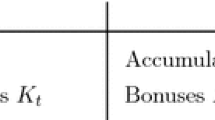Abstract
We develop an approach for practitioners for setting up the target value of investment fluctuation reserves for autonomous Swiss pension funds and determine a desirable level for them to better ensure benefits payments during times of volatile financial markets. The Swiss pension legislation does not stipulate any methodology and requirements for setting up such reserves. We give an overview of methods used and suggest some improvements based on our experience as many pension funds are underfunded after 2008. A suggested approach will help trustees to better comply with funding and solvency requirements for Swiss pension funds.

Similar content being viewed by others
Notes
One can reach at retirement a pension of up to 85% of the last salary for pensions from the first and second pillar together if a savings plan was set up correspondingly.
We will not cover group life insurance contracts in this publication as they are supervised separately in the framework of Swiss Solvency Test for Swiss insurers.
Where we refer to a funding (or financing) strategy we mean a contribution policy together with strategic and tactical asset allocations and surplus & underfunding policy defining how any possible surplus could be used/distributed and how any possible deficit is going to be eliminated and by whom.
ALM stands for Asset Liability Management.
Although maximum limits on different asset classes are stated in Swiss legislation, the pension trustees have to possibility to extend them provided that the security of the pension fund is not impaired.
Basel II was developed based on Basel I and is a framework designed to encourage good risk management by tying regulatory capital requirements to the results of internal systems and processes assessments, thereby creating incentives for improvements in risk management. In addition to making the calculation of regulatory capital more risk sensitive and recognising the quality of internal risk management systems, the framework added two pillars to the model: the supervisory review process and the market discipline.
The Value-at-Risk of a portfolio is defined to be the loss that is expected to be exceeding only α x 100% of the time over a fixed time interval. The α-Value of 0.05 corresponds to the confidence interval of 95%.
The Conditional Value-at-Risk, also called Expected Shortfall, at α% level is the expected loss in the worst α% of the cases.
For the sake of simplicity, we assume in this illustrative example that expected values are equal to historical means and standard deviation.
Backtesting is a statistical procedure where actual profits and losses are systematically compared to corresponding VaR estimates.
References
“Swiss funds hit historic returns low—15 January 2009”, Investment & Pensions Europe (IPE). http://www.ipe.com/articles/print.php?id=30248
“Swiss Pensionskasse born out of buffer concerns—24 June 2009” in IPE. http://www.ipe.com/articles/print.php?id=32053
Watson Wyatt Worldwide “2009 Global Pension Assets Study. Executive summary”, January 2009. http://www.watsonwyatt.com/research/resrender.asp?id=200901-GPAS
Watson Wyatt Worldwide “2008 Global Pension Assets Study. Executive summary”, January 2008. http://www.watsonwyatt.com/research/resrender.asp?id=200801-GPAS08
Aktuell V (2009) Nr. 13, 26 March 2009. http://www.schweizerpersonalvorsorge.ch/zeitschrift/vorsorge-aktuell, p 2
Munaretto N, Bertschi L (2008) “Pensions in Switzerland: Setting the rate”, Investment & Pensions Europe (IPE), October, p 38
Bertschi L, Zanella P, Munaretto N (2008) “ALM-Studien bei Vorsorgeeinrichtungen. Anwendung und Verifizierung verschiedener Modelle in der Praxis”, Der Schweizer Treuhänder 9:683–688
Sandström A (2007) “Solvency—a historical review and some pragmatic solutions”, Mitteilungen der Schweizerischen Aktuarvereinigung, Heft 1:11–34
Jaschke SR (2002) The Cornish-Fisher expansion in the context of Delta-Gamma-normal approximations. J Risk 4 (4):1–14
Andriev A, Kanto A, Malo P (2005) On closed-form calculation of CVAR, Helsinki school of economics working papers, W-389, September
Author information
Authors and Affiliations
Corresponding author
Rights and permissions
About this article
Cite this article
Bertschi, L., Roueche, J. & Munaretto, N. Solvency requirements for Swiss pension funds and how to ensure the guarantee of benefit payments at any time. Eur. Actuar. J. 1 (Suppl 2), 185–197 (2011). https://doi.org/10.1007/s13385-011-0017-1
Accepted:
Published:
Issue Date:
DOI: https://doi.org/10.1007/s13385-011-0017-1




